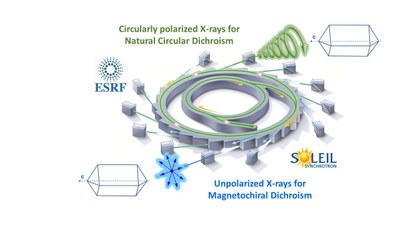Seminar: Elizabeth Hillard
| When |
Jun 24, 2025 à 10:30 AM |
|---|---|
| Where |
Salle Collet |
X-ray natural circular dichroism in transition metal model complexes
Elizabeth A. Hillard,1 , Nazanin Kordestani,1 Philippe Sainctavit,2 Alessandro de Frenza,2 James Ablett,3 Edwige Otero,3 Andrei Rogalev4
(1) Univ. Bordeaux, CNRS, Bordeaux INP, ICMCB, UMR 5026, F-33600 Pessac
(2) CNRS, Sorbonne Univ., MNHN, IMPMC, UMR 7509, 4 pl. Jussieu, F-75252 Paris cedex 05
(3) Synchrotron SOLEIL, L'Orme des Merisiers, Départementale 128, 91190, Saint-Aubin
(4) European Synchrotron Radiation Facility (ESRF), F-38043 Grenoble
elizabeth.hillard@icmcb.cnrs.fr
Natural Circular Dichroism (NCD), the differential absorption of right- and left-circularly polarized light, serves as a common technique for the stereochemical characterization of both molecules and macromolecules. Although NCD is predominantly employed within the ultraviolet-visible (UV-Vis) spectral range, its extension to the X-ray regime—referred to as X-ray Natural Circular Dichroism (XNCD)—offers distinct advantages, including element specificity and low birefringence.1
To date, all XNCD investigations have utilized synchrotron radiation sources, particularly those at the ESRF beamline ID12. These studies have focused primarily on the K-edges of light transition metals2 and the L₂,₃-edges of heavier elements, including lanthanides.3
Our research aims to broaden the scope of X-ray optical activity by developing novel experimental techniques and applying them to molecular crystals, with a particular emphasis on transition metal coordination complexes.
In this presentation, we will highlight our recent advancements in the field, including:
- the observation of colossal XNCD in tetrahedral 3d coordination complexes;
- the detection of XNCD in non-chiral systems;
- the observation of X-ray magnetochiral dichroism in discrete molecular systems;
- the development of Resonant Inelastic X-ray Scattering-NCD (RIXS-NCD).
These results will be presented in conjunction with a presentation of our approach to the conception and synthesis of model systems.
[1] J. Goulon, A. Rogalev and C. Brouder, in Comprehensive Chiroptical Spectroscopy, N. Berova, et al., Eds. (John Wiley & Sons, Ltd., Hoboken, 2011), pp. 457–491.
[2] A. Srinivasan, M. Cortijo, V. Bulicanu, A. Naim, R. Clerac, P. Sainctavit, A. Rogalev, F. Wilhelm, P. Rosa and E. A. Hillard, Chem. Sci. 9, 1136–1143 (2018).
[3] D. Mitcov, M. Platunov, C. D. Buch, A. Reinholdt, A. R. Døssing, F. Wilhelm, A. Rogalev and S. Piligkos, Chem. Sci. 11, 8306–8311 (2020).




